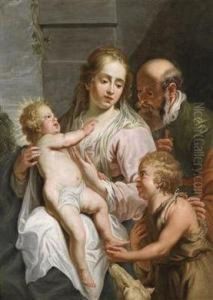Pierre Joseph Verhaghen Paintings
Pierre Joseph Verhaghen was a Flemish painter born on March 9, 1728, in Aarschot, then part of the Habsburg Netherlands. He became best known for his large-scale historical and religious paintings. Verhaghen’s style was deeply influenced by the grand manner of French Rococo and Neoclassical masters, as well as the dramatic expressiveness of Baroque artists like Peter Paul Rubens.
Verhaghen studied under Balthasar Beschey in Antwerp and later in Paris. Despite these influences, he developed a distinct style characterized by vibrant use of color and a dynamic composition. His work was marked by a blend of traditional Flemish painting techniques with the emerging Neoclassical ideals of harmony and restraint.
Throughout his career, Verhaghen received significant commissions that allowed him to create monumental works, some of which are found in churches and public buildings across Belgium. His paintings often depicted scenes from the Bible and classical antiquity, imbued with a sense of drama and emotion that was well received by his contemporaries.
Verhaghen's career reached its zenith when he was appointed court painter to the Habsburg governor in the Netherlands. Despite his success, the French Revolution brought about significant changes, and Verhaghen's style fell out of favor as tastes shifted towards more modern artistic movements. Nevertheless, he continued to paint until his death on April 3, 1811, in Leuven.
After his death, Verhaghen's works continued to be appreciated by art historians and collectors, although he never gained the same level of fame as some of his contemporaries. Today, his paintings can be found in various museums and collections in Europe, testament to the enduring quality of his artistic contributions.





